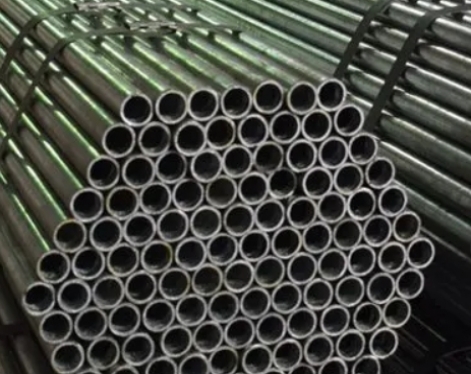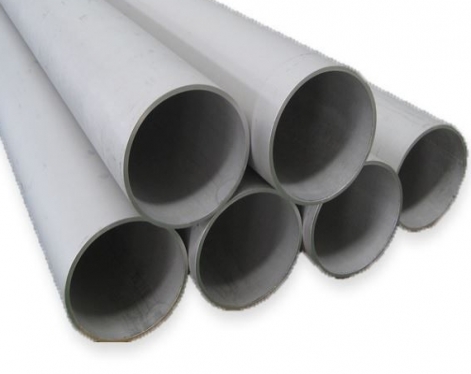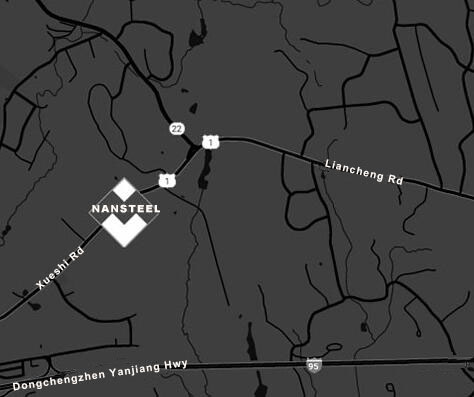What is galvanized erw pipe?
Galvanized ERW Pipe, that is, Electric Resistance Welded Pipe is a product that has been galvanized. It uses hot-rolled or cold-rolled steel strip as raw material, which is first curled into a tube by a forming machine, and then the edge of the tube is heated and melted by resistance welding and welded under pressure to make a resistance welded tube, which is finally galvanized. As a common industrial pipe, galvanized erw pipe has both the characteristics of electric resistance welded pipe and the advantages brought by the galvanized layer, and plays an important role in many fields.
Manufacturing process of galvanized erw pipe
1. ERW pipe production
The high-frequency resistance welding (Electric Resistance Welding) process is used to continuously form and weld steel strips (coils) into steel pipes.
The ERW pipe production process has the characteristics of high efficiency, low cost and high weld strength.
2. Galvanizing treatment
Hot-dip galvanizing (HDG): Place the ERW pipe (black pipe) in a molten zinc tank for hot-dip galvanizing treatment and immerse it in molten zinc liquid (about 450°C) to form a thicker zinc layer (usually 50-150μm), which has strong anti-rust ability and is suitable for outdoor environments.
Electro galvanizing (EG): Galvanizing by electrolysis, the zinc layer is thinner (5-20μm), the surface is smoother, but the anti-rust ability is weaker, and it is mostly used for indoor or short-term protection.
It should be noted that a too thin galvanized layer may not provide sufficient anti-corrosion protection, while a too thick layer may increase the internal stress of the coating, which is prone to peeling and cracking. Therefore, in actual operation, it is necessary to comprehensively consider the anti-corrosion requirements and process costs, and select the appropriate galvanized layer thickness.

Common specifications of galvanized erw pipes
Outer diameter range: DN15 (1/2") ~ DN600 (24")
Wall thickness range: 0.8mm ~ 10mm
Material: Q195, Q235, Q345, SPCC, ST37 and other low carbon steel
Galvanizing layer thickness (hot-dip galvanizing):
Ordinary grade ≥45μm
Thickened grade ≥80μm
Features of galvanized erw pipe
The advantages of galvanized erw pipes are very significant. The welding quality is quite high. The resistance welding technology is used. The weld undergoes a recrystallization process and is consistent with the chemical composition of the parent material. The internal stress is improved through annealing treatment, and the comprehensive mechanical properties are good. The production cost is also low. Its raw material is hot-rolled steel coil, which can realize continuous assembly line operation and has high production efficiency. Its cost advantage is particularly prominent in thin-walled, small-diameter pipes and low-pressure and medium-pressure applications.
At the same time, its weld is not obvious, the heat affected zone of resistance welding is small, the weld is narrow and low, and the inner and outer welds are usually removed after welding, making the inner wall of the pipeline smooth and the fluid resistance small. When transporting liquid or gas, it can improve the transportation efficiency and reduce energy consumption. Moreover, the galvanized layer gives it excellent corrosion resistance, which can effectively resist the erosion of the atmosphere, water and various chemical media, and extend the service life of the pipeline.
Application fields of galvanized erw pipe
Galvanized ERW pipes are widely used in various industrial and civil fields, such as water, gas, oil pipelines, building structures, agricultural irrigation systems, etc. due to their excellent anti-corrosion performance and low cost. Especially in high-pressure and low-pressure transmission systems such as oil and natural gas, ERW steel pipes are favored for their high production efficiency and low cost.
1. Construction industry: scaffolding, steel structure, door and window frames, guardrails, roof drain pipes.
2. Municipal engineering: water supply pipelines, fire protection pipelines, low-pressure gas transmission.
3. Agriculture: greenhouse brackets, irrigation systems.
4. Power communication: wire casing, cable protection tube (such as KBG/JDG tube).
5. Automobile manufacturing: some chassis parts, exhaust pipes (partially using galvanized pipes).
6. Furniture industry: shelves, table and chair brackets.
Read more: Advantages of ERW Pipes in the Construction Field
Galvanized ERW Pipe, that is, Electric Resistance Welded Pipe is a product that has been galvanized. It uses hot-rolled or cold-rolled steel strip as raw material, which is first curled into a tube by a forming machine, and then the edge of the tube is heated and melted by resistance welding and welded under pressure to make a resistance welded tube, which is finally galvanized. As a common industrial pipe, galvanized erw pipe has both the characteristics of electric resistance welded pipe and the advantages brought by the galvanized layer, and plays an important role in many fields.
Manufacturing process of galvanized erw pipe
1. ERW pipe production
The high-frequency resistance welding (Electric Resistance Welding) process is used to continuously form and weld steel strips (coils) into steel pipes.
The ERW pipe production process has the characteristics of high efficiency, low cost and high weld strength.
2. Galvanizing treatment
Hot-dip galvanizing (HDG): Place the ERW pipe (black pipe) in a molten zinc tank for hot-dip galvanizing treatment and immerse it in molten zinc liquid (about 450°C) to form a thicker zinc layer (usually 50-150μm), which has strong anti-rust ability and is suitable for outdoor environments.
Electro galvanizing (EG): Galvanizing by electrolysis, the zinc layer is thinner (5-20μm), the surface is smoother, but the anti-rust ability is weaker, and it is mostly used for indoor or short-term protection.
It should be noted that a too thin galvanized layer may not provide sufficient anti-corrosion protection, while a too thick layer may increase the internal stress of the coating, which is prone to peeling and cracking. Therefore, in actual operation, it is necessary to comprehensively consider the anti-corrosion requirements and process costs, and select the appropriate galvanized layer thickness.

Common specifications of galvanized erw pipes
Outer diameter range: DN15 (1/2") ~ DN600 (24")
Wall thickness range: 0.8mm ~ 10mm
Material: Q195, Q235, Q345, SPCC, ST37 and other low carbon steel
Galvanizing layer thickness (hot-dip galvanizing):
Ordinary grade ≥45μm
Thickened grade ≥80μm
Features of galvanized erw pipe
The advantages of galvanized erw pipes are very significant. The welding quality is quite high. The resistance welding technology is used. The weld undergoes a recrystallization process and is consistent with the chemical composition of the parent material. The internal stress is improved through annealing treatment, and the comprehensive mechanical properties are good. The production cost is also low. Its raw material is hot-rolled steel coil, which can realize continuous assembly line operation and has high production efficiency. Its cost advantage is particularly prominent in thin-walled, small-diameter pipes and low-pressure and medium-pressure applications.
At the same time, its weld is not obvious, the heat affected zone of resistance welding is small, the weld is narrow and low, and the inner and outer welds are usually removed after welding, making the inner wall of the pipeline smooth and the fluid resistance small. When transporting liquid or gas, it can improve the transportation efficiency and reduce energy consumption. Moreover, the galvanized layer gives it excellent corrosion resistance, which can effectively resist the erosion of the atmosphere, water and various chemical media, and extend the service life of the pipeline.
Application fields of galvanized erw pipe
Galvanized ERW pipes are widely used in various industrial and civil fields, such as water, gas, oil pipelines, building structures, agricultural irrigation systems, etc. due to their excellent anti-corrosion performance and low cost. Especially in high-pressure and low-pressure transmission systems such as oil and natural gas, ERW steel pipes are favored for their high production efficiency and low cost.
1. Construction industry: scaffolding, steel structure, door and window frames, guardrails, roof drain pipes.
2. Municipal engineering: water supply pipelines, fire protection pipelines, low-pressure gas transmission.
3. Agriculture: greenhouse brackets, irrigation systems.
4. Power communication: wire casing, cable protection tube (such as KBG/JDG tube).
5. Automobile manufacturing: some chassis parts, exhaust pipes (partially using galvanized pipes).
6. Furniture industry: shelves, table and chair brackets.
Read more: Advantages of ERW Pipes in the Construction Field









